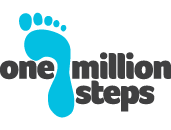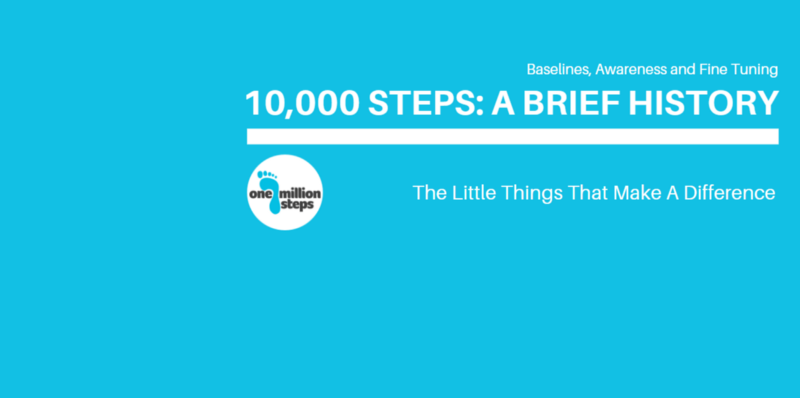
AKA “No! It’s NOT a made-up number!”
We hope that most Million Steppers have accepted, at some level, that 10,000 steps is something that can benefit your health.
So why are we even bothering to bring it up? Because, inevitably, just when you are feeling proud of yourself for having clocked in a good day of walking, there is that one person who will say “You know, I read somewhere 10,000 steps is a made-up number to sell pedometers”
UGH! And it matters because doubt eats away at the passion and energy you have.
And anyway, now you have a reply to that person. Besides, it’s fun! And I learnt some fascinating things as I was looking into this.
The History of Step Counting
The following is an extract of Step Counting: A Review of Measurement Considerations and Health-Related Applications
Step counting began as a method of estimating distance. Thus, it is a logical extension of other measurement methods based on the human body, including the inch (i.e., width of thumb), the hand (i.e., width of the palm), the foot (i.e., length of the foot), the cubit (i.e., distance from elbow to fingertip), and the fathom (i.e., distance between fingertips with arms outstretched). The word mile comes from the Latin phrase milia passuum, meaning “one thousand paces.” The Roman mile was approximately 1000 paces (or 2000 steps) of a full-grown adult.
Leonardo da Vinci is credited with inventing the first mechanical step counter. It was worn at the waist, with a long lever arm that was tied to the thigh. When the thigh moved back and forth in walking, the gears were rotated, causing steps to be counted.
Thomas Jefferson commissioned a step counter made by one of the best watch-makers in Paris. It was worn in a vest pocket, and had a lever arm which was tied to a string that passed through a hole in the bottom of the vest pocket. The other end of the string was tied to a strap below the knee, and walking caused it to pull on a lever arm attached to gears. He used his pedometer to measure out the distance to Paris landmarks in steps. Jefferson noted an English mile would require 2066.5 steps, while the brisk walk of winter reduced it to 1735 steps. He sent a pedometer to James Madison in 1788 along with a detailed one-page letter of instructions.
In 1777, Abraham-Louis Perrelet, a Swiss-born watchmaker invented a self-winding mechanism for pocket watches that used an oscillating weight inside the watch that moved up-and-down during walking. In 1780 he invented a self-contained pedometer that also used a spring-suspended lever arm to count steps. In 1820, Abraham-Louis Breget designed a mechanical pedometer/stopwatch for Alexandre I, Tsar of Russia, for use in measuring the distance and pace of his marching armies.
A Simple and Extremely Short History of 10,000 Steps
In the 1960s, a Japanese research team led by Dr Yoshiro Hatano, a professor at the Kyushu University of Health and Welfare, began to worry about the rise in obesity in Japan.
The team determined that the average Japanese walked between 3000 to 5000 steps a day. They reasoned if this were increased to 10,000 steps a day, it equated to approximately 300 to 400 kcal per day (depending on speed and body size and factors like age, gender, and current weight). But the team realised it could amount to 20 kg of weight loss a year.
The Research of Dr Hatano’s team and the arrival of the 1964 Tokyo Olympics brought renewed focus on physical activity and healthy living.
The Yamasa company in Tokyo, Japan (internationally known as Yamax) designed a manpo–kei (10,000 steps meter) in 1965 . The 10,000 steps per day slogan originated in Japan around 1965, shortly after the Tokyo Olympics. This was believed to be the amount of physical activity that would be sufficient to decrease the risk of coronary heart disease. Source
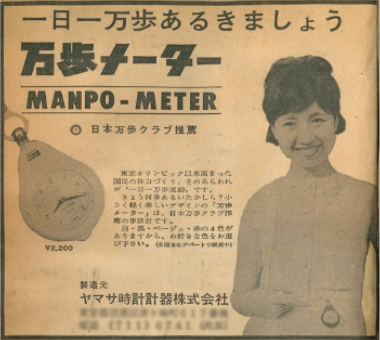
Manpo-kei is literally written 万歩計
- 万: man — 10,000
- 歩: po — step
- 計: kei — measure
Over the last 40 years, the idea of 10,000 steps a day, and the research, slowly advanced; with the work of Catrine Tudor-Locke & David R. Bassett Jr most often referred to. In 2004 Tudor-Locke and Bassett introduced the concept of a graduated step index for healthy adults.
Index of levels of physical activity according to daily steps:
- Sedentary adults: <5,000 steps
- Low Activity: 5,000–7,499 steps
- Somewhat active: 7,500–9,999 steps
- Active: >10,000 steps
- Highly Active: >12,500 steps
But ….
“Preliminary evidence suggests that a goal of 10 000 steps/day may not be sustainable for some groups, including older adults and those living with chronic diseases. Another concern about using 10 000 steps/day as a universal step goal is that it is probably too low for children, an important target population in the war against obesity”. Source
This meant that the results were further defined for different groups and abilities(see below image. Source )
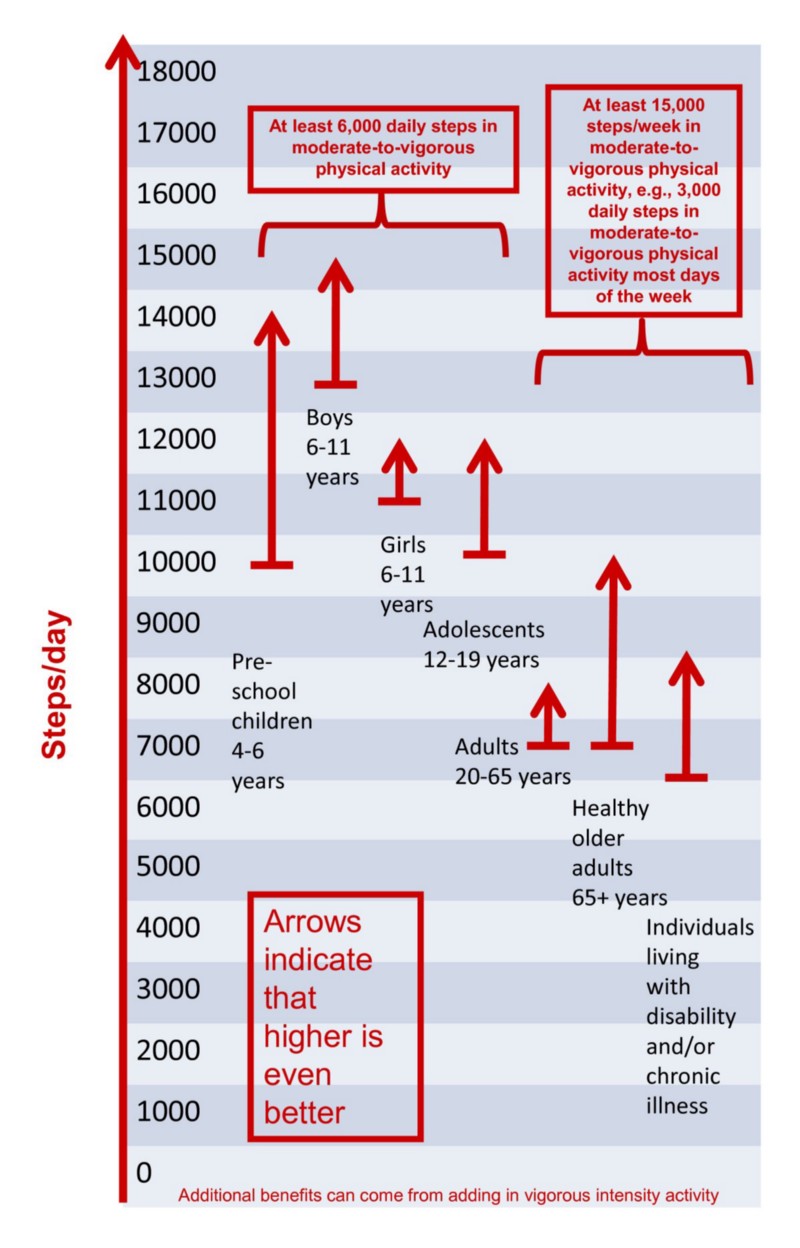
Today, the National Health Service, World Health Organization (WHO), US Center for Disease Control (CDC), US Surgeon General, American Heart Foundation, US Department of Health & Human Services and health organisations around the world use 10,000 steps a day as a GENERAL benchmark for physical activity
And there is further guidance and advice based on a specific group you may be in.
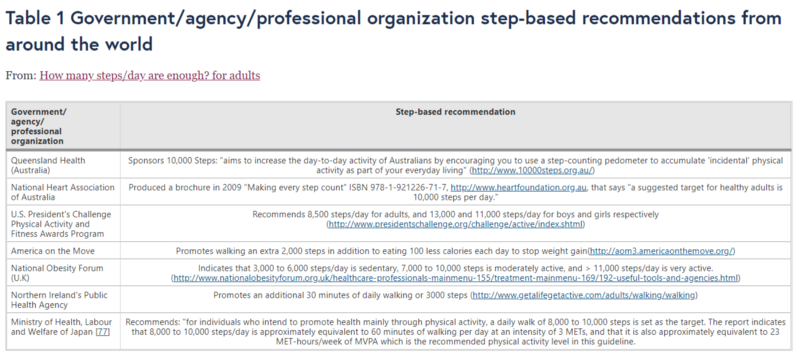
The bottom line of all that research and recommendations is neatly summed up in the following quote:
It makes sense that step-based recommendations should be harmonious with existing evidence-based public health guidelines that recognize that “some physical activity is better than none” while maintaining a focus on time spent in moderate-to-vigorous physical activity (MVPA) Source
Which is why the physical activity guidelines put an emphasis on getting 30 minutes of those faster-paced walks or active minutes.
Is 10,000 steps a made-up number? Not really, no. There are over 40 years of research.
Is 10,000 steps the correct number for all of us? Again, not always. We are just too different but we know there are good guidelines.
The important thing is this: You can get better at walking. You can get faster. But Just Start. It really is something.
Suggested Reading:
- Revisiting ‘‘How Many Steps Are Enough?’’ by Catrine Tudor-Locke, Dr Yoshiro Hatano, Robert P. Pangrazi, and Minsoo Kang
- Manpo-Kei: The Art and Science of Step Counting by Catrine Tudor-Locke
- Step Counting: A Review of Measurement Considerations and Health-Related Applications David R. Bassett, Jr., Lindsay P. Toth, Samuel R. LaMunion, and Scott E. Crouter
- Controlled study designs that have informed “how many steps/day are enough?” in adults
To find out more about the Million Steps Challenge and how we can help you, your business or charity, please visit https://millionsteps.com
Or Register your organisation interest: Million Steps CoVid-19 Package here
